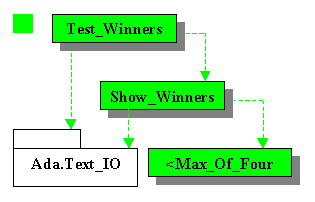------------------------ Max_Of_Four --------------------------
-- This function selects the largest of four integers.
-- It has four return statements.
---------------------------------------------------------------
function Max_Of_Four(A,B,C,D : Integer) return Integer is
begin
if (A >= B) and (A >= C) and (A >= D) then
return A;
elsif (B >= C) and (B >= D) then
return B;
elsif (C >= D) then
return C;
else
return D;
end if;
end Max_Of_Four;
---------------------------------------------------------------
------------------------ Show_Winners -------------------------
-- This procedure displays the names of winners and the number
-- of winners if there is a tie. It has one return statement.
---------------------------------------------------------------
with Max_Of_Four;
with Ada.Text_IO;
use Ada.Text_IO;
procedure Show_Winners(A,B,C,D : in Integer) is
Count : Integer := 0;
begin
if A = Max_Of_Four(A,B,C,D) then
Count := Count + 1;
Put_Line("Adam is a winner.");
end if;
if B = Max_Of_Four(A,B,C,D) then
Count := Count + 1;
Put_Line("Bill is a winner.");
end if;
if C = Max_Of_Four(A,B,C,D) then
Count := Count + 1;
Put_Line("Carl is a winner.");
end if;
if D = Max_Of_Four(A,B,C,D) then
Count := Count + 1;
Put_Line("Dave is a winner.");
end if;
if Count = 1 then
Put_Line("There is only one winner.");
return; -- return statement
end if;
Put_Line("There are " & Integer'Image(Count)
& " Winners");
end Show_Winners;
---------------------------------------------------------------
----------------------- Test_Winners --------------------------
-- This test procedure creates two cases: one with a single
-- winner and one with a three-way tie.
---------------------------------------------------------------
with Show_Winners;
with Ada.Text_IO;
use Ada.Text_IO;
procedure Test_Winners is
begin
Put_Line(" First Case");
Show_Winners(8, 12, 18, 13);
New_Line;
Put_Line(" Second Case");
Show_Winners(20, 15, 20, 20);
end Test_Winners;
---------------------------------------------------------------
|
